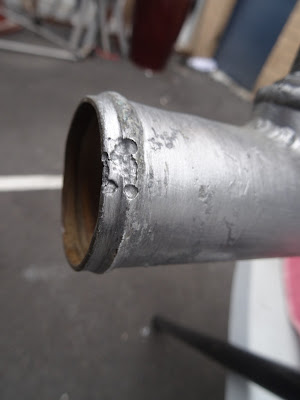And sadly I have done very little to the car since Christmas however this distinct lack of focus and dedication will be rectified shortly. There have however been a few things happening in the background .........
Polishing Polishing Polishing
I did do something over the Christmas break, which was to polish the tub!! This counts as progress in my mind. All the scratches, dents and general wear and tear marks remain but it is clean.
Fuel Bags
So the new fuel bags have arrived, they have been manufactured by ATL (Aero Tec Laboratories USA). This has taken quite a ling time and they look well made. Although the 'soft' rubber originals were sent to the manufacturer for reference along with photos of the access holes etc the new bags have been made from a more 'firm' compound than the originals. Given that I was almost in tears trying to get the original soft rubber bags out I am not looking forward to attempting to install these new bags.
Engine Components
As mentioned in a prior Blog, obtaining new engine components for this V12 BRM manufactured engine has been more time consuming than was anticipated but I suspect I was overly ambitious. Some components have also required re-machining or corrective work. Rodney Gibbs my engine builder (Superior Automotive Services) and I have learned a lot in the process and will be far better placed for the next engine rebuild, although I need to actually get the car running in the first instance so I can complete the 1,500 miles to then require a rebuild.
New pistons, connecting rods and cylinder liners
These lovely, albeit very expensive, components arrived and they are a sight to behold. Given that each of the 12 pistons has a swept volume of only 250 cc each they are small and somewhat jewel like and I catch myself handling them as if they are delicate.
The pistons were manufactured by Omega and the connecting rods by Arrow. The pistons are individually custom made and the connecting rods are specials made to order.
Both manufacturers are very professional and reputable companies with a long and successful motorsport history.
Rodney also specified that the gudgeon pins be DLC coated.
There was a problem however.
The piston diameters were the same size as the new cylinder liner bores. The 'matching' pistons and liners were not compatible as there was no clearance.
The pistons specified a specific bore diameter / clearance which meant that the bores of the 12 new liners required honing by around 2.5 thou of an inch each. A bit frustrating.
Rodney arranged for a fine engineering machine shop to undertake this work. In order to accurately mount the liners whilst they were being honed, a 4 cylinder Ford engine block was purchased from the wreckers and bored out so that our new liners would fit inside and they could be mounted true and held securely during honing. Noting that there were 12 of them to be honed.
Eventually this distracting task was completed and everything now fits as it should have, and with much precision.
The cylinder liners fit into the block as illustrated above.
Speaking of which, the block has had a few hits in it's time. Given that this engine (car) was stored by BRM after 1974 and subsequently on display at the Donnington Museum this internal blow up damage and welded repair would have been from it's competition events. Given these engines ran to 12,500 rpm in their day that could potentially have been a spectacular blow up.
Other components have also recently arrived from Hall and Hall, including valve springs, block studs, new oil pump housings, new hard anodised aluminum scavange pump gears, DLC coated cam followers, etc. Rodney has also sourced a range of bits and pieces including Titanium valve followers, new inlet and exhaust valves and various engine bearings etc.
The availability of various scarce engine components from Hall and Hall in the UK (either as original unused items from their BRM parts inventory or new components made to a H&H pattern) has been a godsend. Although I did check that some parts were available from H&H when I purchased the car it has been interesting to discover that the engine in my P160E-10 has a few unique properties, such as it being one of the very few big valve units.
Original scavenge pump gear on the left. As can be seen, it has encountered a few bits of broken metal in the circulating oil during competitive running and the gears and the housings in which they ran were also in pretty bad shape (gouged and worn). The pump would have been operating with very reduced efficiency (lower volume and pressure) as the clearances were pretty large and the teeth were almost grinding together when turned.
Shiny titanium.
Rodney admiring the collection of new and refurbished parts.
There are so many parts but this is a V12 motor so for some items there are multiples of 12, such as 48 valves, 48 valve guides, 48 retainers, 96 springs - seems like more parts than stars in the sky.
Now we have finally obtained almost all the parts Rodney just needs to assemble it all.
LIKE SOON!!!
The fuel metering unit has also been serviced by Crawford Hall and to my and Rodney's great delight this engine component was like new. I simply had to open a bottle of Penfolds Bin 28 to celebrate. It would have been negligent to do otherwise.
Water Pipes
So after a few months break I thought a bit of light polishing would be a good simple way to ease back into the job. So I removed the water pipes that run under the tub from the engine to the front radiator, grabbed a few other aluminum items that needed cleaning and sat outdoors to enjoy the work.
I noticed a hose clamp on one of the pipes with what appeared to be a rubber compound under and also a red hard rubber band on one of the pipes, which I initially assumed were to stop the pipes rattling in their tunnels under the tub.
Alas, underneath were some pin holes.
Not ideal.
More detailed examination of the inside of the pipes identified some serious corrosion.
Given these pipes had been sitting at BRM in storage from 1974 to 1980 then at the Donnington Museum full of fluid from 1980 until late 2015 this should not really be a surprise.
There is also some interesting corrosion under where the rubber hoses connected as well.
The above looks like termite borer damage.
So the pipes are off to David Mawer to have a new pair manufactured. One pipe also has some nice compound curves which will keep Dave amused.
I have no idea what the spring rates are so I took them to Eibach Springs in Sydney for testing.
The photo above is of Robert van Os the Managing Director undertaking the tests on each spring.
The results were interesting and indicated that the two rear springs had significantly different spring rates despite being of the same dimensions etc. This is indicated in the graph above.
The graph also illustrates (by way of a curve), the increasing spring rate with increased compression because the rear springs are 'progressive' in design. As can be seen in the photo below the spring coils become increasingly tighter towards the bottom which increases the spring tension on increased compression.
The spring rates in the car at right height were measured by Robert as:
Fronts - LH 228 lbs, RH 217 lbs
Rears - LH 365 lbs, RH 395 lbs
There is a surprising variation in the springs but perhaps BRM were using various springs in different cars and mixed and matched them from race to race. By all accounts funds at BRM were getting tight by 1974 and there may not have been money or time available to purchase new springs or even have the existent springs regularly tested to allow springs to be paired correctly.
I have purchased some new (non progressive) Eibach springs for the rears and with a small collection of 400 lbs, 425 lbs and 450 lbs I would be in a good position to do some testing once the car is running and most importantly once I have done a good number of miles to get a feel for handling at a competitive pace. I will of course paint the springs black to match the existing (sorry Eibach).
The modern Avon A11 compound tyres that are the default race tyre for these 1973 historic F1 cars are also a lot softer than the tyres used in the day and this generally allows you to run a slightly stiffer spring rate.
The 2.5 inch inside diameter 6.5 inch long front springs are not however currently available from Eibach and alas I will need to get a few sets specially manufactured.
































